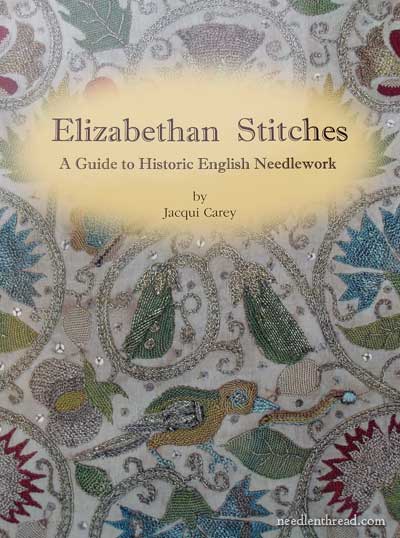Elizabethan Stitches: A Guide to Historic English Needlework by Jacqui Carey has just hit the market – and it’s another one of those “You Definitely Need This” books, whether you’re a fan of historic English needlework or simply a surface embroiderer who is interested in all kinds of stitches and their applications!

The book is the result of the author’s extensive study of historic pieces, and, as she notes in the introduction, her discovery of the discrepancies between the way stitches were actually worked on the 16th & 17th century artifacts she studied and the modern interpretations of these stitches. In the book, Carey sets out to illustrate the variety of stitches used in historic English needlework and their various ways of being executed.
The book, then, is both an instructional book on Elizabethan stitchery, with detailed trouble-shooting of the stitches and their variations, as well as a kind of treatise on the differences between Elizabethan stitchery and modern interpretations of Elizabethan stitchery.

The book begins with introductory and background material. Before getting into the stitches themselves, the author offers some excellent reading material to help clarify Elizabethan embroidery and put it into perspective. There are a few sections at the beginning of the book that I especially like: the section on Needlework in general, with its explanation of terminology (nice to see!), of working methods, and of starting and finishing. I thought these sections well worth reading!

My favorite section at the beginning of the book, though, is the section on materials, their costs, availability, uses, types, and so forth.

I love the close-up photos in this section, showing the various materials used and illustrating the difference between materials available today and those used in the 16th and 17th centuries. I think this section gives us a deeper appreciation of the materials that we do have access to today, and the skill, vision, and dedication of those involved in creating and recreating these materials for our use.

There’s a nice section on design and design sources at the beginning of the book, too. If you are dabbling with the idea of creating Elizabethan embroidered masterpiece, it’s well worth reading!

Then, it’s time to get into the meat o’ the matter: the stitches themselves. The arrangement of the book in the stitchery part is well done – I like the way this part of the book is laid out!
There are four categories of Elizabethan stitchery addressed: needlepoint, braid stitches, looped stitches, and applied work. The instructional part of the book is separated into these four types of stitchery.

For each category of stitchery, the reader receives an explanation of how the stitches were used, up-close detail shots of the stitches on extant samples from the period (front and back, in most cases, which is very nice!), and diagrams demonstrating the working methods of the stitches.

There are further diagrams illustrating the troublesome areas of certain types of stitches – for example, how to work the stitch if traveling in other directions, if turning, and so forth. Of course, the author could never study every single sample of Elizabethan embroidery and demonstrate the variations found. Instead, she illustrates the more prevalent approaches to executing the stitches and dealing with different stitching situations.

Then, after explaining the stitches that fall under the particular category, showing us examples, and teaching us how to do them, the author explores specific case studies – studies of museum pieces that employ the stitchery explored in that section of the book. Each of the case studies involves a narration by the author concerning the piece, what it looks like, the materials used, and so forth, and detailed close-up photos of the piece, often with further diagrams demonstrating how stitches were executed on that particular piece of embroidery.

Each of the four sections of the main content area of Elizabethan Stitches is arranged this way: the explanation of the category; the stitches that belong to the category, broken down and illustrated with diagrams and specific trouble-shooting for difficulty areas; photos of museum pieces close-up and personal; and then the case studies, which often include further stitching instruction.
There are over 30 types of stitches and variations covered in detail this way. The quantity and thoroughness involved in exploring these stitches and variations, plus the detailed visual verification afforded by the extensive photos in the book, sets Elizabethan Stitches apart from, and well above, other books written on the subject of 16th and 17th century embroidery.

By the way, plaited braid stitch is offered with three variations, and if you are familiar with Jacqui Carey’s other book on Elizabethan sweet bags, I think you may find the instruction in Elizabethan Stitches a little easier to get a handle on. Comparing the two books, I find I prefer the instruction in this book better than the instruction in the previous book on Elizabeth sweet bags.

If you have even the slightest interest in historical needlework, by the way, you are just going to love the case studies throughout the book!

After all, most of us will never see these pieces in person, and certainly we will never see them this closely. The photos in the book are magnificent – really fun to gaze upon in awe and wonder!

The book ends with a list of addresses, including museum addresses and supplier information. Handy to have!
The pros of the book are all laid out above! You won’t find another book like it, and if you have any interest in this type of needlework or in the use of historic techniques in modern applications, you don’t have much of a choice: you’ll need this book in your needlework library!
You can find Elizabethan Stitches: A Guide to Historic English Needlework by Jacqui Carey available on the Carey Company website. The book is worth it! Get it while it’s available!
















